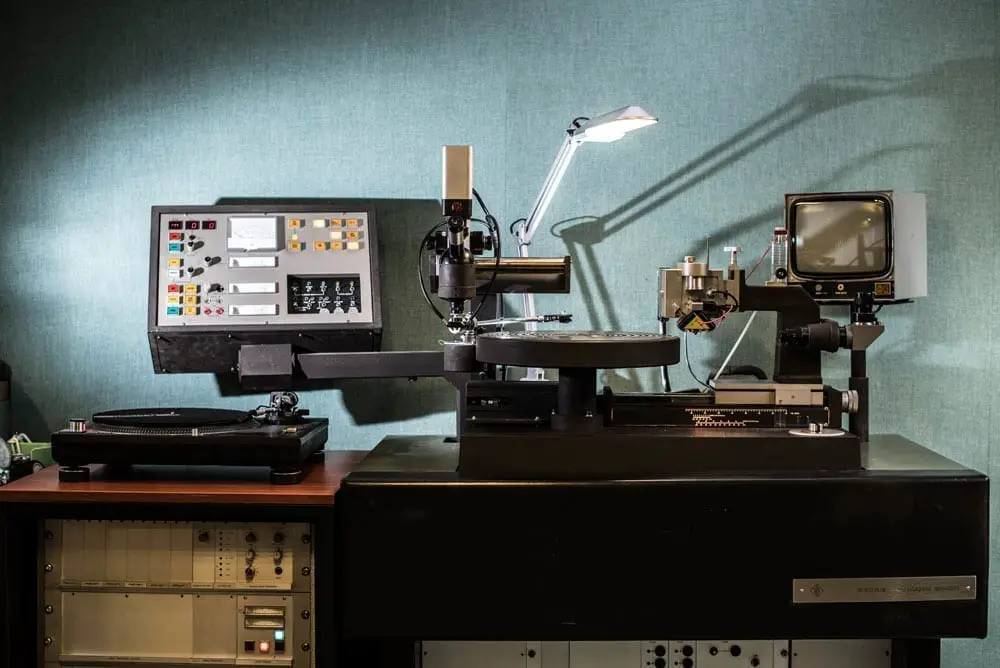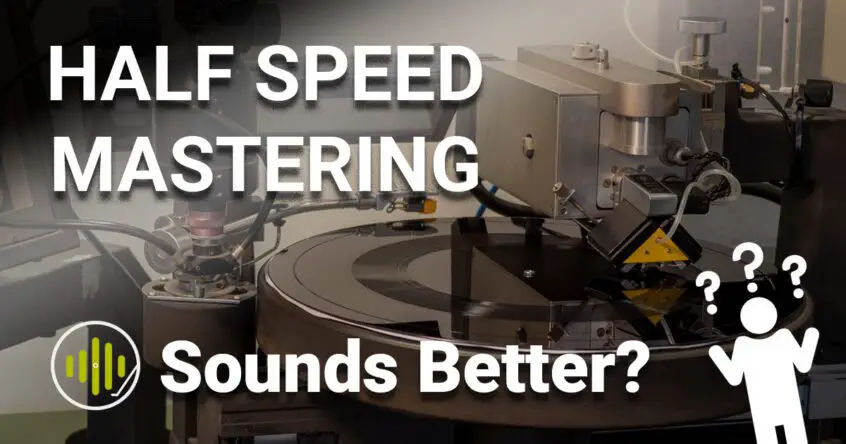Sound Matters offer a simple explanation of half speed mastering as a practice while gaining some more detailed insights from experienced Mastering Engineer, Barry Grint.
Barry’s work includes award-winning artists George Ezra and Tom Walker, plus many classic projects, including Madonna, Prince, Oasis, and many more.
What Is Half Speed Mastering?
To understand what the term “half-speed mastering” means, we must first understand the basics of how a master record disc is cut during the mastering process.
In simple terms, to produce a master record, a lacquer disc is placed on the cutting machine, known as a mastering lathe. The lathe cutting head engraves the source waveform into the lacquer. Once completed, the lacquer master disc is then used to create the stamper that will eventually be used to manufacture vinyl records. The entire process is a highly skilled job and requires a great deal of accuracy.
In the case of half-speed mastering, the whole process is slowed down to, you guessed it, half of the original speed. In other words, a typical 33 1/3 rpm record is cut at 16 2/3rpm. The source material is also slowed down (reducing the pitch in the process) meaning the final record will still sound normal when played back.
What are the Benefits of Half Speed Mastering?
The groove cut into a vinyl record is a physical representation of the sound waves we hear as music.
High-frequencies, by definition, produce very fast, transient cycles that are more difficult to cut than longer low-frequency sound waves.
When you halve the speed, very fast, difficult to cut high-frequency sound becomes much easier to cut mid-range sound.
The cutting head also has twice the amount of time to cut the intricate groove, resulting in a higher quality, more detailed representation of the original sound source.
This more detailed cut can have particular benefits when considering inner-groove distortion, as the natural high-frequency roll-off that happens as the groove progresses toward the record center is greatly reduced.
Cutting heads operating at half speed are also said to draw much less power than when operating at full tilt, which leaves much greater headroom in the amplifier system to respond to sudden power demands. Audibly, the benefit here is heard as greater dynamic response and instrument separation.
In essence, half-speed mastering results in a superior sounding record that is both richer and fuller in the low-mid frequencies, and smoother at the top-end. The stereo image is hugely improved and the overall sound is focused and engaging.
“Cutting at half speed means that information within the source recording at around 17kHz is actually recorded at 8.5kHz, and so is a long way from the point where feedback runs out. This results in a more accurate and more open high-frequency response in the half speed vinyl when compared with a normal speed recording.”
Barry Grint
Interview: Barry Grint on Half Speed Mastering at Air Studios
Barry Grint, Head Mastering Engineer for Alchemy Mastering at Air Studios London has a wealth of experience in half-speed cuts, and was able to embellish on the basics above.
“Half speed vinyl mastering offers many potential sonic benefits as you’ve described, and it’s a process that we’re keen to use wherever it’s viable and feasible”, states Barry. “The Neumann SX 74 Cutterhead that we use at Alchemy Mastering is the most advanced head that Neumann ever designed, which uses feedback to balance its equalization response. This feedback becomes unstable at around 17kHz (leading to slight irregularities in the frequency response at this point), although the frequency response regains its evenness at around 19kHz, from which point it slowly tails off towards 30kHz and beyond.
“Cutting at half speed means that information within the source recording at around 17kHz is actually recorded at 8.5kHz, and so is a long way from the point where feedback runs out. This results in a more accurate and more open high-frequency response in the half-speed vinyl when compared with a normal speed recording.”

As Barry describes, half speed mastering allows an experienced engineer to get the best results out of the most advanced tools on the market. Slowing the whole process down allows more time, which means the end result sounds better and is more efficient — allowing them to minimize the effects of inherent limitations within the vinyl format. Barry adds further detail to this effect:
“We cut variable pitch, meaning two signals are sent to the lathe, one in advance of the other. This ‘look-ahead’ signal gives the pitch control computer contained in the lathe the ability to know what is coming next, and therefore vary the amount of land between the grooves accordingly to make the best use of space on the disc. At half speed, the pitch control computer works even more efficiently enabling better packing of the grooves. In many cases, this can result in louder cuts and it means we are better able to keep the audio recording away from the center of the vinyl disc where the playback frequency response is poorest.”
“The many benefits of half speed mastering will improve most recordings. However, it is not suitable for all material and the audio source needs to be assessed.”
In almost all aspects, a half-speed master will sound better, so why aren’t all vinyl records mastered at half speed? Firstly there is the obvious question of time. By definition, the process takes at least twice as long, meaning that time can play a part in the decision as to whether or not a record receives half-speed treatment. In addition to this, the process also doesn’t suit all source material, as Barry explains:
“The many benefits of half-speed mastering will improve most recordings. However, it is not suitable for all material and the audio source needs to be assessed. Where necessary, tests also need to be carried out before it is decided that a half-speed master is an appropriate way forward. Because we halve the speed—and therefore the pitch—of the source material during the cutting process, any required de-essing (a process that suppresses heavy sibilance) cannot be done in real-time. This means that overly bright and sibilant source material may not be as suitable for half-speed cutting or it may require significantly more preparation.”
Is Half Speed Mastering Better?
Half speed offerers a huge array of potential benefits, but it is by no means a silver bullet.
If the source material isn’t up to scratch, cutting at half speed will not fix any inherent problems, more likely it will only serve to highlight the issues further.
For example, if the material is overly compressed, or simply badly recorded, a half-speed master will by no means make the final result better.
The process requires a high-quality source, the best equipment, a highly-skilled engineer and a great deal more time.
Consequently, half-speed releases are typically reserved for material that justifies the additional time and expense. When it’s done right, though, the difference in sound quality is undoubtedly worth the effort. Good things come to those who wait, as Guinness famously claim.




I enjoy farting
A fart would sound better than most 1/2 witted remasters.
Strange, that with magnetic tape- the higher the speed, the better the quality.
Well, you increase the bandwidth when you record tape at a higher speed. You can get that increased bandwidth by buying albums spread over two discs at 45 rpm. Half-speed mastering is an attempt to get more detail out of the standard 33.33 speed.
Thanks for clearing that one up for me, Dan.
Great article. Anyone interested in exploring the history of recorded sound further may be interested in ‘Perfecting Sound Forever’ by Greg Milner. I’m reading it now. It’s a little technical for me in places but also has insights and observations that have me thinking again about what I expect and look fro in recorded music.
I think these half speed remasters are ok, but often spread out on x2 lp’s at 45 rpm. If I am honest, instead of spending £30, I would rather seek out the original first presses. I recently sold on Dire Straights Brothers in Arms and kept the original, which I think sounds just as good.
Hi, i think you are spot on. One thing i must mention, i bought Blind Faith LP at Half Speed to try for myself. Recorded at the legendary Abbey Road Studios. It arrived broken in two and the banding ruined the outer sleeve. Promptly received a replacement but cover still damaged. The sound on my highe end gear was no better IMHO.
I still seek out originals.
The only LP I have that is a half speed master is Paul McCartney (McCartney).
This record was released last year during Record Store Day. This was the 50th anniversary of this record.
I am comparing this new release to the first pressing of the original album that I have in my collection. The half speed master has zero surface noise and some of the highs are more pronounced on the half speed master.
I’m not sure if I would purchase a record just for the half speed mastering if I already own an earlier copy. I made the decision to stop playing my first pressing so I needed a replacement.
On a side note I wonder what it sounds like in the studio when this half speed master is being created. Does it sound like when I am playing a 45 rpm but forgot to change the setting from 33-1/3 rpm…but worse.
I have quite a few half-speed masters – Queen – A Night At The Opera, The Specials – Specials and More Specials, Japan – Quiet Life, Gentlemen Take Polaroids and Tin Drum, Simple Minds – New Gold Dream. I’m also expecting Bob Marley and the Wailers – Confrontation next week. There may be a couple more but that’s all I can think of off the top of my head.
When vinyl is mastered the anti-RIAA (AKA reversed RIAA) curve is applied. However, this curve is not linear. You can’t simply use slower speed cutting with standard anti-RIAA because the frequencies will be screwed up. Does the process take care of this? I myself use slower speed ripping but I use linear preamps (not phono correctors) to digitally transfer it in order NOT to screw up frequencies.
Spot on observation. 1/2 speed screws up the highs and lows.
The recording of “The WHO Live at hyde park” is absolutely amazing! The vynal is superb sounding!!!So glad I bought rhe vynal instead of the cd.(which im sure sounds good,but you really can’t beat the sound of vynal,the warmth and in this particular Album. AMAZING!!
[…] clocking, refurbishing the cutting amplifiers, and custom modifications to allow us to carry out half-speed cutting. These things don’t just make a difference to vinyl, they impact on everything we […]
I have a project Debut 111 turntable with Ortofon OM50 cartridge. I now want to upgrade the sound so would I be better off purchasing a new cartridge such as the Ortofon 2M Blue or a complete new turntable?
Go with the 2m Black. Absolutely wonderful cartridge. Takes about 100 hours to really shine, but I’m amazed. Tight, clean bass, clean highs, everything is beautifully balanced. The 2m bronze uses the same body without the shibata stylus.